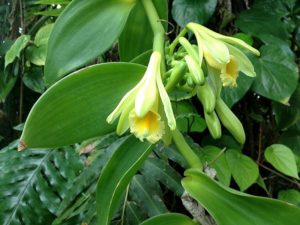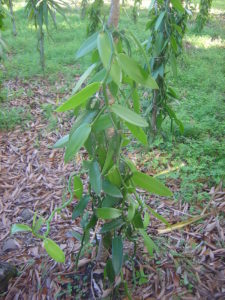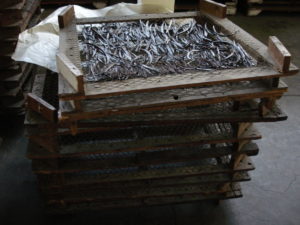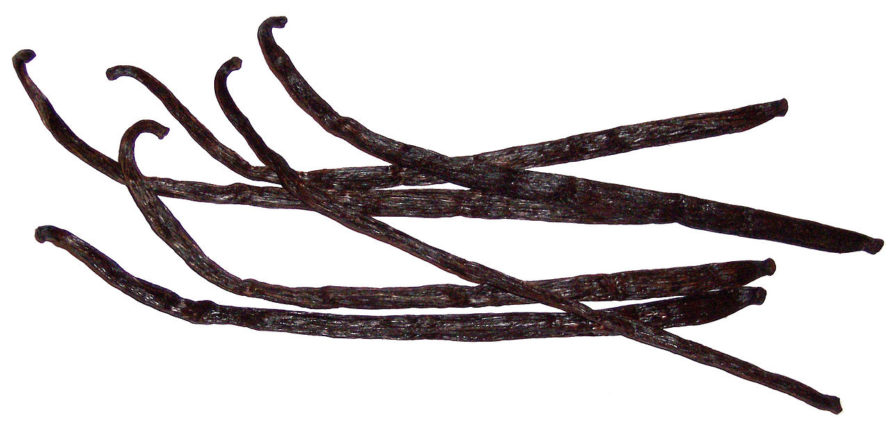
Vanilla orchid flower
Vanilla (Vanilla planifolia) is the fruit of a vining orchid native to Mexico. The Aztecs used it to flavor cocoa. After the Spanish conquest in the 1520’s, both cocoa and vanilla were introduced to Europe by Hernan Cortes. It was another 300 years before anyone was able to coax the vines into fruit outside of Mexico.
The problem was that the flowers were pollinated by insects found only in Mexico. The most common was the tiny Melipone bee. Growers tried introducing the bee to Europe but it didn’t survive. Finally in 1837 a Belgian Botanist by the name of Charles François Antoine Morren, discovered how the plant was pollinated by watching the bees. He then tried to imitate them and artificially pollinate the flowers. He was successful but the process he used was so unwieldy that it was not widely adopted.

Vanilla plantation
In 1841, a 12 year old slave named Edmond Albius who lived on the island of Réunion in the Indian Ocean, discovered how to hand pollinate the flowers and worldwide production of vanilla took off. The orchids are most commonly grown in Mexico, Caribbean Islands and Central and South American, Madagascar and surrounding Indian Ocean islands, and Tahiti and other Polynesian islands. Albius’ pollination method is still in use today, one of the reasons that vanilla is the second most expensive spice in the world after saffron.
The vanilla orchid can only be grown in the tropics. It is hardy in US growing zones 10 through 11. Ideal growing temperatures are in the 70s and 80s Fahrenheit. Nighttime temperatures should not fall below 60⁰F. It is a vine that normally grows up trees and can reach a length of 20- to 30-feet. It does best in light shade.
When grown on plantations, the vines are supported by trees or poles. As they grow, they are bent down towards the ground to prevent them from becoming too long and difficult for the plantation workers to reach the flowers and resulting beans. Vines are productive for 12 to 14 years and produce 50 to 100 beans per year. To obtain vanilla beans, the flowers must be pollinated within 12 hours of opening. The vines flower in the spring but not all at the same time, so plantation workers must check them each morning and hand pollinate each flower that has opened that day.

Drying vanilla beans
Beans start developing five to six weeks after pollination. They take six months to mature. After that they must go through a complex and labor intensive process before they are ready for market. First they are boiled to stop the growing process. Beans that are too ripe do not have as much flavor. Then they are left in the sun for a few hours a day for a week. Finally, they are stored in closed boxes for six months to fully develop their flavor. The beans are graded by length and lack of blemishes. They highest grades go to professional chefs. The lower grades are sold in the general market.
You can grow vanilla orchids at home in containers provided you provide them with support to grow on. Wood is preferable. Use cedar or cypress because they don’t rot easily. Vanilla orchids like high humidity. Use a potting mix that is specific for orchids. This will provide the roots with the right drainage. Allow the potting mix to dry out between waterings. Orchids like humidity but they don’t like their roots to be wet. Temperature and light are also key. Partial shade or indirect light is best. Temperatures between 70⁰F and 90⁰F are necessary. Anything cooler than that will slow down growth of your vine.
Flowering will begin once the vine reaches three to five feet in length. The flowers appear on a spike and will open consecutively over a period of weeks. You will need to hand pollinate the flowers with a toothpick if you want beans. Pollinate each flower as soon as possible after it opens or at least within 12 hours.

